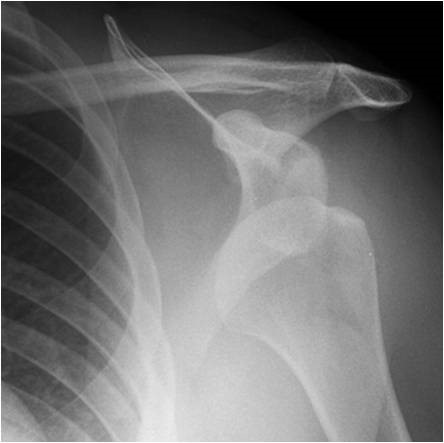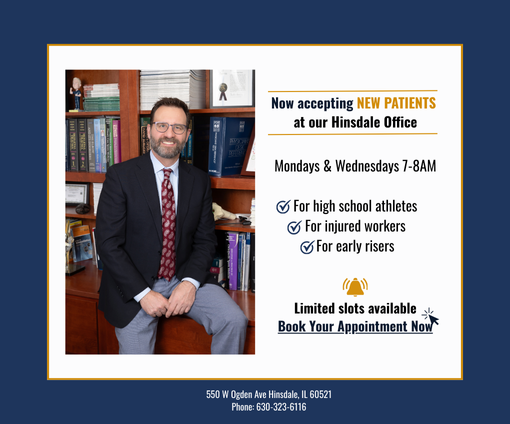
Arthroscopic expert, Dr. Steven Chudik, cites prompt treatment, thorough evaluation and physical therapy as key factors to successful return from shoulder dislocation injury
As an expert arthroscopic shoulder surgeon and sports medicine specialist, Dr. Steven Chudik with the Shoulder, Knee and Sports Medicine Injury Clinic in Westmont and Western Springs, Ill., has seen and treated countless dislocated shoulders in his practice the past 16 years.
According to Dr. Chudik, the shoulder possesses a remarkable range of motion, making it one of the most mobile and important joints in the body, and the joint most commonly dislocated. Most dislocations occur in young, active people in their teens to mid-20s. More than one-half of the shoulder injuries in high school sports are dislocations that occur when the athlete’s arm is forced upward and outward behind the athlete’s body dislocating the humeral head (ball of the upper arm bone) out the front of the glenoid (shoulder socket). This injury also can tear ligaments and the labrum that help hold and stabilize the ball in socket
“Shoulder dislocations are serious injuries,” Dr. Chudik explained. “Fortunately, if treated properly and in a timely manner, athletes with shoulder dislocations can return to play.”
When a shoulder dislocation occurs during a sporting event, team athletic trainers and/or a team physician will examine the athlete to insure no other injuries have occurred and reduce (move) the shoulder back in place. This quick response from the medical team is important to restore blood flow to the dislocated humeral head and to reduce the shoulder atraumatically (without further injury) before the shoulder muscles start to spasm and tense… Following the reduction, early evaluation by a sports medicine physician is important to determine the extent of the injury.
A physical examination, X-rays, and a MRI are generally performed to rule-out neurovascular (nerves and blood vessels) injuries, fractures, and ligament or rotator cuff tears. Some fractures and tears to the rotator cuff require early surgery. Age is the biggest influence on the prognosis of the dislocations. Dislocations in people younger than age 40 usually have isolated capsulolabral tissue (labrum, capsule, and ligaments) injuries and surgery is necessary to prevent future dislocations. When individuals older than age 40 dislocate their shoulder, they are at higher risk to tear their rotator cuff and require surgery Signs and symptoms of an anterior dislocation (most common) may include, but are not limited to:
- Severe pain
- Loss of shoulder/arm function
- Loss of or decreased wrist pulse. This may indicate blood vessel involvement that can cause decreased circulation to the arm. This is a serious problem requiring emergent care.
- Numbness, tingling, weakness, or paralysis of the arm
- Shoulder wanting to “fall out of place”
- Shoulder deformity noted
After the shoulder is reduced back in place, the physician will refer the patient to a physical therapist to restore the motion, strength, proprioception (position sense) and shoulder function. Following several weeks in an appropriate rehabilitation program, some in-season athletes may return to play; however, most contact sports require bracing to help prevent further dislocations. Braces restrict motion and may hinder performance and preclude return to certain positions and sports (throwing arm in quarterbacks and wrestling).
Without surgery to repair (re-attach) the labrum and ligaments in the shoulder, athletes younger than age 25 have an 80 to 100 percent chance of repeat dislocation. Recent studies also suggest that early surgery results in a better outcome as related to recurrent dislocations, development of arthritis and patient satisfaction.
Dr. Chudik performs this type of surgery arthroscopically with specialized instruments and a tiny camera inserted through a few small incisions usually less than .5 cm to 1 cm long. Following surgery, the shoulder is in a sling for six weeks and physical therapy resumes with a specific rehabilitation program to regain strength, mobility and normal function to the affected shoulder.
Return to activities and contact sports are typically allowed after four to six months. Success rates and patient satisfaction are high, with low risks for repeat dislocation.
Dr. Chudik is renowned for his arthroscopic shoulder expertise and innovative procedures that reduce shoulder surgical trauma, speed recovery and yield excellent outcomes. If you or someone you know suffers from shoulder pain or any of the symptoms described earlier following a fall, consider scheduling an appointment with Dr. Steven Chudik at 630-324-0402, or schedule on his website at https://www.stevenchudikmd.com/schedule-online/. He has convenient hours and clinic locations plus onsite X-ray and MRI imaging capability.









